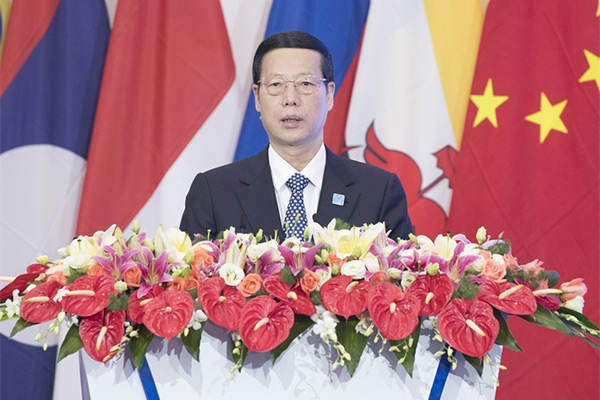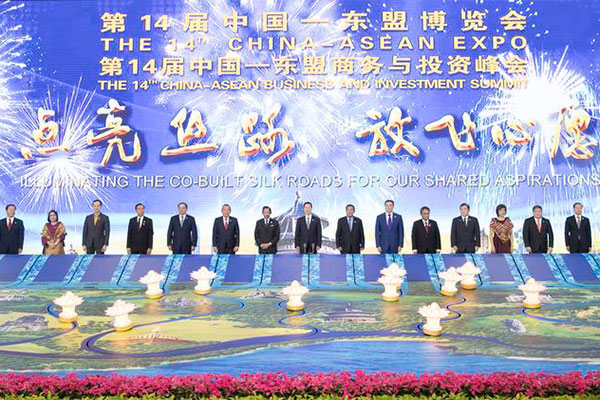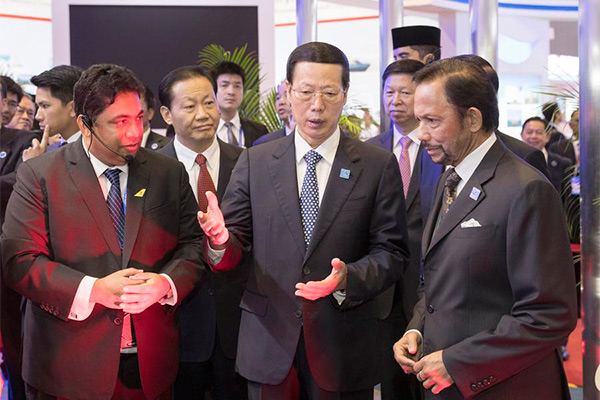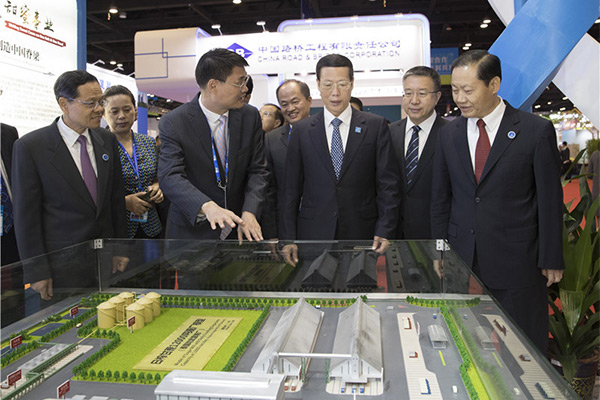
Vice-Premier Zhang Gaoli delivers a speech during the opening ceremony of the 14th China-ASEAN Expo and the China-ASEAN Business and Investment Summit in Nanning, capital of South China’s Guangxi Zhuang autonomous region, Sept 12, 2017. [Photo/Xinhua]
NANNING — “Shared benefits,” “common destiny” and “inclusive growth” were some of the most frequently mentioned phrases at the 14th China-ASEAN Expo that opened on Sept 12.
With the theme of “Co-Building the 21st Century Maritime Silk Road, Promoting Regional Economic Integration through Tourism,” the expo is expected to inject new vitality to the ancient trade route and enhance mutually beneficial cooperation between China and the Association of Southeast Asian Nations (ASEAN).
“While the Belt and Road Initiative was proposed by China, it brings benefits to the whole world,” Vice-Premier Zhang Gaoli said at the opening ceremony of the expo which is taking place in Nanning, capital of South China’s Guangxi Zhuang autonomous region.
This year marks the 50th anniversary of ASEAN, and next year marks the 15th anniversary of China-ASEAN strategic partnership.
Over the past years, the two sides have already made big strides in various areas including trade, policy, infrastructure and people-to-people exchanges. Deeper, broader collaboration will bring the ties even closer.

Vice-Premier Zhang Gaoli delivers a speech during the opening ceremony of the 14th China-ASEAN Expo and the China-ASEAN Business and Investment Summit in Nanning, capital of South China’s Guangxi Zhuang autonomous region, Sept 12, 2017.[Photo/Xinhua]
SHARED BENEFITS
China has been ASEAN’s biggest trading partner for eight years, while ASEAN has been China’s third largest trading partner for six years.
From 1991 to 2016, bilateral trade volume grew nearly 56 folds while two-way cumulative investment volume rose nearly 355 folds, according to Zhang.
In the first seven months of this year, China-ASEAN trade volume increased 14.5 percent year on year, higher than China’s overall trade growth rate.
The upgrade of the China-ASEAN Free Trade Area, already in effect, will inject new impetus to bilateral economic and trade development, Zhang said.
In terms of finance, China and the 10 ASEAN countries were among the founding members of the Asian Infrastructure Investment Bank, which since 2016 has provided funding totaling $2.8 billion to 17 projects in nine developing countries in Asia.
The 100-billion-yuan ($15.32 billion) additional funding for the Silk Road Fund as well as special loans offered by the country’s policy banks to support the Belt and Road Initiative will benefit ASEAN countries, Zhang said.
China is also ASEAN’s largest source of foreign tourists. In 2016, more than 38 million trips were made between the two sides and more than 2,700 flights operated every week.
The fruitful achievements have proved that the Belt and Road Initiative is in the common interests of all parties and in line with regional and global collaboration trends, Zhang said.
According to Brunei’s Sultan Haji Hassanal Bolkiah, China has been consistently supporting the economic growth of ASEAN countries, and Brunei is glad to see that China and ASEAN are working together to implement policies to push Asia as a growth engine for global economy.
Hassanal said he was “particularly inspired” by the Silk Road Economic Belt and the 21st Century Maritime Silk Road. The Belt and Road Initiative has highlighted the importance of interconnectivity in different areas, including infrastructure, trade and investment, and is particularly important to address challenges such as rising protectionism.
Hassanal said that it would be good to explore ways to synergize the goals of the Belt and Road Initiative and Master Plan on ASEAN Connectivity 2025, which tries to promote sustainable infrastructure, digital innovation, seamless logistics, regulatory excellence and people mobility.

Vice-Premier Zhang Gaoli (8th L) attends the unveiling ceremony for the opening of the 14th China-ASEAN Expo and the China-ASEAN Business and Investment Summit with foreign dignitaries and guests, in Nanning, capital of South China’s Guangxi Zhuang autonomous region, Sept 12, 2017. [Photo/Xinhua]
PROMISING FUTURE
The expo, together with other initiatives and projects, will lift the China-ASEAN relationship to a new stage.
The four-day event has attracted 2,709 exhibitors, up 1.5 percent from the previous year, while the number of buyers is expected to exceed 10,000, including about 4,000 international buyers, official data showed.
The expo serves as an important platform to show the deepened economic and trade ties between China and ASEAN, and has attracted many small and medium-sized enterprises from Brunei, which are the country’s major source of employment, said Hassanal.
Along with the expo, China and ASEAN are exploring new ways, as well as fields, in which to collaborate.
China is willing to expand cooperation in tourism with ASEAN, as this year marks the China-ASEAN Year of Tourism, Zhang said.
As China and ASEAN both have abundant tourism resources with their own characteristics, increasing trips made between the two sides have played an important role in enhancing exchange and understanding between their peoples, according to Zhang.
In terms of trade, Zhang also stressed the need for full implementation of a protocol signed in 2015 on upgrading the China-ASEAN Free Trade.
“China is willing to expand imports from ASEAN countries. We welcome them to attend the first China International Import Expo to be held in 2018,” Zhang said.
China is also willing to, along with ASEAN, push ahead talks on the Regional Comprehensive Economic Partnership (RCEP), which was launched in 2012. The RCEP talks involve the 10 ASEAN members and their six major trading partners — China, Japan, the Republic of Korea, India, New Zealand and Australia — with the aim of facilitating expansion of regional trade and investment.
Cooperation in industrial capacity is also expected to speed up.
“China’s equipment is cost efficient, and it has advantages in technology, training and financing, enabling China and ASEAN countries to nurture new comparative advantages and create new room for economic growth,” Zhang said.
In addition, China will actively engage in cooperation with ASEAN in environmental protection, ecological restoration and the circular economy, in a bid to “build a green Silk Road,” Zhang said.

Vice-Premier Zhang Gaoli (C front) and Brunei’s Sultan Haji Hassanal Bolkiah (R front) attend the opening ceremony of Brunei pavilion after the opening of the 14th China-ASEAN Expo and the China-ASEAN Business and Investment Summit, in Nanning, capital of South China’s Guangxi Zhuang autonomous region, Sept 12, 2017. [Photo/Xinhua]
OPEN ECONOMY
The expo takes place at a time when the anti-globalization sentiment has imposed threats to regional economic integration.
Bucking the trend, China steadfastly adheres to the opening-up strategy, despite sluggish growth, acute imbalance and rising protectionism in the world economy.
“We would like to work with the international community to enhance dialogue, coordination and cooperation for an open world economy,” Zhang said.
He promised to expand the entry of foreign capital into China’s service and manufacturing sectors, better protect intellectual property rights and promote fairness for domestic and foreign enterprises.
In the following five years, China will import commodities worth $8 trillion, invest $750 billion abroad and record 700 million overseas trips.
“We welcome ASEAN members to share more major opportunities brought by China’s development,” Zhang said.

Vice-Premier Zhang Gaoli (3rd R) visits exhibition booths after the opening ceremony of the 14th China-ASEAN Expo and the China-ASEAN Business and Investment Summit, in Nanning, capital of South China’s Guangxi Zhuang autonomous region, Sept 12, 2017.[Photo/Xinhua]
